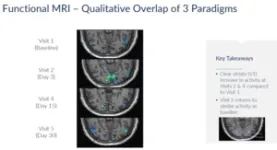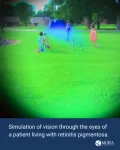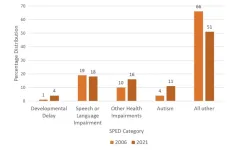(Press-News.org) An international research team led by investigators at Virginia Commonwealth University has identified for the first time markers that may indicate early in life if a person has susceptibility to schizophrenia.
The ability to predict the risk of developing schizophrenia later in life may allow early detection and intervention, which the researchers hope can reduce the impact of the disease on individuals, families and communities. Their results have been published in Molecular Psychiatry.
Schizophrenia is a serious psychiatric disorder that is most often detected in young adulthood. It affects as much as 1% of the world population and can cause debilitating effects such as a sense of losing touch with reality. People with the disorder are up to three times more likely to die early and often face discrimination, social isolation and debilitating physical illness, according to the World Health Organization.
Although schizophrenia involves an inherited genetic component there is strong evidence that environmental factors play a role in whether a person develops the disease. These environmental factors can trigger chemical changes to DNA that regulate what genes are turned on or off through a process called methylation.
Studying possible genetic triggers for a disease like schizophrenia is complicated because methylation changes can be caused by the disease itself and related factors such as the stress and medications that usually accompany it.
Because of the effects of the disease on the methylome — the term for the set of nucleic acid methylation modifications in an organism's genome or in a particular cell — ideally samples would be obtained before the disease occurs. But since schizophrenia is a disorder of the brain, this would be impossible.
To resolve this problem the research team — led by VCU School of Pharmacy professors Edwin van den Oord, Ph.D, and Karolina Aberg, Ph.D. — devised a unique approach.
First, they examined blood samples that had been drawn shortly after birth from 333 infants in Sweden, tracking 24 million methylation marks. The team used statistical analysis that allowed them to study methylation marks on a cell-type-specific level.
“Since the sampled blood was collected within hours of birth, years before any schizophrenia symptoms occurred, these findings cannot be influenced by the disease itself or other postnatal factors,” noted Aberg, principal investigator for the study and associate director of the Center for Biomarker Research and Precision Medicine at VCU.
Next, the team validated any significant findings from the blood samples by comparing them to transcriptional data from 595 postmortem brain samples from different people — some with schizophrenia and others in a control group who did not have the disease. The brain samples were provided by investigators from around the world including Europe, North America and Australia.
The team also compared their findings against methylation data from adult blood drawn from schizophrenia cases and controls — a total of 2,970 people.
The researchers concluded that certain differences in methylation already present in newborns indicate an increased risk of developing schizophrenia.
“In other words, we could identify methylation differences between individuals that later on in life would develop schizophrenia and controls that are unique to specific cell-types in the neonatal blood,” said van den Oord, the first listed author of the paper in Molecular Psychiatry and director of the Center of Biomarker Research and Precision Medicine. “Research will continue around these methylation differences to develop potential future clinical biomarkers that will allow early detection and intervention.”
This work was supported by a $2.3 million grant from the National Institute of Mental Health. Labwork and analysis took place at VCU’s Center for Biomarker Research and Precision Medicine, which is affiliated with VCU School of Pharmacy.
END
DNA methylation markers for increased risk of schizophrenia identified for first time in newborns
The ability to predict the risk of developing schizophrenia later in life may allow early detection and intervention.
2023-04-27
ELSE PRESS RELEASES FROM THIS DATE:
Geneticists link phenotype of Balto, famed sled dog, to modern breeds
2023-04-27
ITHACA, N.Y. – A Cornell University-led project has added a new chapter to the story of Balto – the most famous sled dog in history – by using ancient DNA extraction and analysis to reconstruct his phenotype and identify his genetic connections to modern dog breeds.
The research reveals Balto’s lineage was genetically healthier and less inbred than modern breeds, with characteristics adapted to the extreme environment of 1920s Alaska.
The team’s paper, “Comparative Genomics of Balto, a Famous Historic Dog, Captures Lost Diversity of 1920s Sled Dogs,” published April 27 in Science.
Heather Huson, associate professor of animal science ...
Highly dexterous robot hand can operate in the dark -- just like us
2023-04-27
New York, NY—April 27, 2023—Think about what you do with your hands when you’re home at night pushing buttons on your TV’s remote control, or at a restaurant using all kinds of cutlery and glassware. These skills are all based on touch, while you’re watching a TV program or choosing something from the menu. Our hands and fingers are incredibly skilled mechanisms, and highly sensitive to boot.
Robotics researchers have long been trying to create “true” dexterity in robot ...
Texas Tech researchers contribute to groundbreaking mammal research
2023-04-27
Why was Balto, a famous sled dog from the 1920s, able to survive the unforgiving conditions of Alaska? It was one of many findings uncovered through the Zoonomia Project, which involved researchers from Texas Tech University.
More than a dozen researchers from the Department of Biological Sciences were among the major collaborators in the Zoonomia Project who will publish their multi-year comparative genomic analysis of mammals and the influence of genetic change on health and disease in the April 28 issue of Science magazine.
The laboratory of David Ray, professor and associate chair of the department, studies transposable elements ...
Snowballing effects of beech leaf disease hurt helpful root fungi
2023-04-27
The American beech, Fagus grandifolia, is a North American staple and the dominant species in many northeastern forests. In 2012, a new disease was first spotted, infecting trees in northeastern Ohio. The worst afflicted had dark banding on their leaves, which emerged crumpled and leathery in the spring. Not until 2018 would experts discover the nematode pest, Litylenchus crenatae mccannii, overwintering in the buds of infected trees.
As it marches across the continent, researchers are still ...
Higher rates of autism and attention deficit/hyperactivity disorder in American children
2023-04-27
In a recent publication released by PubMed, American scientists led by Dr. Dufault at the Food Ingredient and Health Research Institute, reported alarming increases in the numbers of children requiring special education services. While student enrollment in US schools remained stable from 2006-2021, the percentage of children receiving special education services increased 10.4%. Of the three disability categories under which children with autism may receive services, autism caseload percentages tripled jumping from 4% to 11% while developmental delay caseload ...
Improving geriatric surgical quality is feasible for a wide range of hospitals
2023-04-27
Key takeaways
Feasible for small and large hospitals: Pilot institutions in the study included community hospitals and academic medical centers representing every region of the United States.
Geriatric surgical patients are a growing population: American College of Surgeons standards for geriatric surgery address a growing population that most hospitals serve.
Standards help address barriers to implementation: ACS geriatric surgery standards help hospitals identify and address challenges to providing optimal care, including staffing, manpower, and lack of geriatricians in many hospitals.
CHICAGO: ...
Scripps Research preclinical study finds insomnia drug blocks oxycodone relapse
2023-04-27
LA JOLLA, CA—The insomnia drug suvorexant (Belsomra®) might be an effective treatment for opioid use disorder, according to a preclinical study from Scripps Research.
In the study, published April 27, 2023, in Frontiers in Pharmacology, the Scripps Research scientists found that suvorexant reduced prescription opioid intake and helped protect against relapse in rats modeling opioid use disorder (OUD). If the results translate to humans in clinical trials, the insomnia drug could offer a promising approach for the millions of people who have OUD.
“Our results suggest that repurposing suvorexant could be a good strategy for reducing drug intake and blocking relapse in cases ...
Calling all canines: Help sniff out the dangerous spotted lanternfly
2023-04-27
From New York to North Carolina and as far west as Illinois, the invasive spotted lanternfly is causing chaos in many states where agricultural and forestry industries are essential to the economy. It has been estimated that crops and forest production losses caused by insects and pathogens are close to $40 billion a year.
Spotted laternflies, native to mainland China, prey upon 70-plus host plant species, stealing their nutrients with their piercing snouts, called stylets. They are often characterized as “hitchhikers” for their ability to move ...
AGS honors expert & emerging geriatrics leaders at 2023 Annual Scientific Meeting (#AGS23)
2023-04-27
New York (April 27, 2023) – The American Geriatrics Society (AGS) annually honors researchers, clinicians, educators, and emerging health professionals who have made outstanding contributions to high-quality, person-centered care for older adults. This year’s award recipients include 19 leaders representing the breadth of medical disciplines championing care for us all as we age.
Clinical Student Research Award
Matthew Ryan Cosmai
Clinician of the Year Award
Shelley R. McDonald, DO, PhD
David H. Solomon Memorial Public Service Award
Alan Lazaroff, ...
Plastic particles themselves, not just chemical additives, can alter sex hormones
2023-04-27
Amid rising evidence that additives designed to improve plastics also disrupt sex hormones, a Rutgers laboratory trial shows that plastic itself can do likewise when inhaled at moderate levels.
Previous studies focused on chemicals such as bisphenol-A (BPA) that make plastics stiffer or more flexible. These findings spurred ongoing efforts to find safer plastic additives.
The Rutgers study showed that microscale and nanoscale particles (MNPs) of polyamide, a common plastic better known as nylon, produced endocrine-disrupting ...
LAST 30 PRESS RELEASES:
Making lighter work of calculating fluid and heat flow
Normalizing blood sugar can halve heart attack risk
Lowering blood sugar cuts heart attack risk in people with prediabetes
Study links genetic variants to risk of blinding eye disease in premature infants
Non-opioid ‘pain sponge’ therapy halts cartilage degeneration and relieves chronic pain
AI can pick up cultural values by mimicking how kids learn
China’s ecological redlines offer fast track to 30 x 30 global conservation goal
Invisible indoor threats: emerging household contaminants and their growing risks to human health
Adding antibody treatment to chemo boosts outcomes for children with rare cancer
Germline pathogenic variants among women without a history of breast cancer
Tanning beds triple melanoma risk, potentially causing broad DNA damage
Unique bond identified as key to viral infection speed
Indoor tanning makes youthful skin much older on a genetic level
Mouse model sheds new light on the causes and potential solutions to human GI problems linked to muscular dystrophy
The Journal of Nuclear Medicine ahead-of-print tip sheet: December 12, 2025
Smarter tools for peering into the microscopic world
Applications open for funding to conduct research in the Kinsey Institute archives
Global measure underestimates the severity of food insecurity
Child survivors of critical illness are missing out on timely follow up care
Risk-based vs annual breast cancer screening / the WISDOM randomized clinical trial
University of Toronto launches Electric Vehicle Innovation Ontario to accelerate advanced EV technologies and build Canada’s innovation advantage
Early relapse predicts poor outcomes in aggressive blood cancer
American College of Lifestyle Medicine applauds two CMS models aligned with lifestyle medicine practice and reimbursement
Clinical trial finds cannabis use not a barrier to quitting nicotine vaping
Supplemental nutrition assistance program policies and food insecurity
Switching immune cells to “night mode” could limit damage after a heart attack, study suggests
URI-based Global RIghts Project report spotlights continued troubling trends in worldwide inhumane treatment
Neutrophils are less aggressive at night, explaining why nighttime heart attacks cause less damage than daytime events
Menopausal hormone therapy may not pose breast cancer risk for women with BRCA mutations
Mobile health tool may improve quality of life for adolescent and young adult breast cancer survivors
[Press-News.org] DNA methylation markers for increased risk of schizophrenia identified for first time in newbornsThe ability to predict the risk of developing schizophrenia later in life may allow early detection and intervention.







